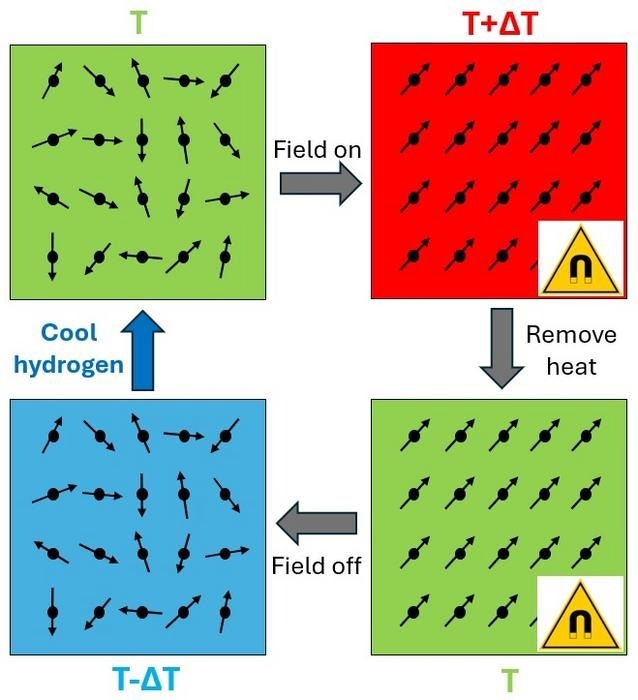A research team led by Graeme Blake, an Assistant Professor of Inorganic Chemistry at the University of Groningen in the Netherlands, is exploring a more energy-efficient approach known as magnetocaloric cooling. The approach, detailed in a study published in the journal Nature Communications, not only reduces energy consumption but also avoids the use of refrigerant gases, which contribute significantly to greenhouse effects.
 Upper left: the magnetocaloric material starts in the magnetically disordered (paramagnetic) state at temperature T. Upper right: an external magnetic field is applied and causes the material to enter the magnetically ordered (ferromagnetic) state, with a consequent rise in temperature to T+ΔT. Lower right: heat is transferred away from the material to reduce its temperature back to T. Lower left: the magnetic field is removed and causes the material to lose its magnetic order, returning to the paramagnetic state and decreasing the temperature to T-ΔT. Heat can now be removed from the substance to be cooled (hydrogen), raising the temperature of the magnetocaloric material back to T (upper left). Image Credit: University of Groningen / Blake lab
Upper left: the magnetocaloric material starts in the magnetically disordered (paramagnetic) state at temperature T. Upper right: an external magnetic field is applied and causes the material to enter the magnetically ordered (ferromagnetic) state, with a consequent rise in temperature to T+ΔT. Lower right: heat is transferred away from the material to reduce its temperature back to T. Lower left: the magnetic field is removed and causes the material to lose its magnetic order, returning to the paramagnetic state and decreasing the temperature to T-ΔT. Heat can now be removed from the substance to be cooled (hydrogen), raising the temperature of the magnetocaloric material back to T (upper left). Image Credit: University of Groningen / Blake lab
Hydrogen ideally needs to be in liquid form to be viable as fuel for vehicles or for chemical storage of surplus renewable energy. However, achieving this requires cooling hydrogen to -253 °C (20 K), a highly energy-intensive process with conventional cooling methods.
The energy-efficient approach relies on materials that heat up under a magnetic field, with the generated heat then transferred to a heat sink. When the magnetic field is removed, the material and its surroundings cool down.
Blake applied magnetocaloric cooling to achieve 20 K, the temperature necessary to liquefy hydrogen. While this cooling method has been previously accomplished, it typically requires materials containing rare-earth metals, whose extraction is energy-intensive and environmentally damaging. The breakthrough with Blake's material lies in its lack of rare-earth metals, offering a more sustainable alternative.
Our material, or a future variant of it, could probably reduce the cost and improve the environmental friendliness of this cooling technology.
Graeme Blake, Assistant Professor, Inorganic Chemistry, University of Groningen
Journal Reference:
Levinsky, J. J. B., et al. (2024) Giant magnetocaloric effect in a rare-earth-free layered coordination polymer at liquid hydrogen temperatures. Nature Communications. doi.org/10.1038/s41467-024-52837-x.